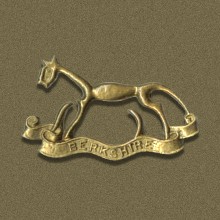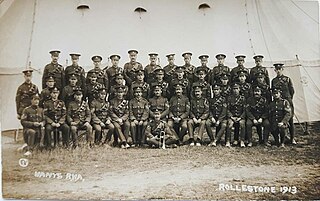Related Research Articles
The Australian Mounted Division originally formed as the Imperial Mounted Division in January 1917, was a mounted infantry, light horse and yeomanry division. The division was formed in Egypt, and along with the Anzac Mounted Division formed part of Desert Column, Egyptian Expeditionary Force in World War I. The division was originally made up of the Australian 3rd Light Horse Brigade, the reconstituted 4th Light Horse Brigade, and two British yeomanry brigades; the 5th Mounted Brigade and 6th Mounted Brigade.
The Yeomanry Mounted Division was a Territorial Force cavalry division formed at Khan Yunis in Palestine in June 1917 from three yeomanry mounted brigades. It served in the Sinai and Palestine Campaign of the First World War, mostly as part of the Desert Mounted Corps. In April 1918 six of the regiments were withdrawn from the division and sent to France, being converted from Yeomanry to battalions of the Machine Gun Corps. These were replaced by Indian Army cavalry regiments withdrawn from France, and the division was renamed 1st Mounted Division, the third such division to bear that title. In July the combined division was renamed as the 4th Cavalry Division.

The Berkshire Yeomanry was a part time regiment of the British Army formed in 1794 to counter the threat of invasion during the French Revolutionary Wars. It was the Royal County of Berkshire's senior volunteer unit with over 200 years of voluntary military service. After taking part in the Second Boer War, it saw action as mounted troops in the First World War and as artillery in the Second World War. Its lineage is maintained by 94 Signal Squadron, part of 39 (Skinners) Signal Regiment. The Headquarters of the Squadron is based in Windsor, Berkshire. The Berkshire Yeomanry had a number of battle honours won from Europe to the Far East and Private Frederick Potts was awarded a Victoria Cross for service during the Gallipoli Campaign.

The 3rd Cavalry Division was a division of the British Army in the First World War. It was formed at Ludgershall, Wiltshire England in September 1914 under the command of Major-General the Hon. Julian Byng. The division moved to Belgium in the first week of October 1914, landing at Ostend, although its third Brigade was only formed there once. During the war the division took part in most of the major actions where cavalry were used as a mounted mobile force, and also many where the troops were dismounted and effectively served as infantry.
The 1st Mounted Division was a Yeomanry Division of the British Army active during World War I. It was formed in August 1914 for the home defence of the United Kingdom from four existing mounted brigades of the Territorial Force, each of three regiments of Yeomanry. The divisional order of battle changed often, as the 1st Line brigades left for service overseas and were replaced by 2nd Line formations. It was converted to the 1st Cyclist Division in July 1916, and was broken up in November 1916 without being involved in active service. It remained in East Anglia throughout its existence.
The 1st South Midland Mounted Brigade was a yeomanry brigade of the British Army, formed as part of the Territorial Force in 1908.
The 2nd South Midland Mounted Brigade was a yeomanry brigade of the British Army, formed as part of the Territorial Force in 1908.
The London Mounted Brigade was a yeomanry brigade of the British Army, formed as part of the Territorial Force in 1908.
The North Midland Mounted Brigade was a yeomanry brigade of the British Army, formed as part of the Territorial Force in 1908.

The Nottinghamshire and Derbyshire Mounted Brigade was a yeomanry brigade of the British Army, formed as part of the Territorial Force in 1908.
The 8th Cavalry Brigade was a cavalry brigade of the British Army in World War I. It was formed in Belgium in 1914 and served on the Western Front as part of the 3rd Cavalry Division. It left the 3rd Cavalry Division on 14 March 1918.
The 1st South Western Mounted Brigade was a formation of the Territorial Force of the British Army, organised in 1908. By 1915 its regiments had been posted away so it was broken up; it never saw active service as a brigade. The Headquarters may have formed the HQ for 2/1st Southern Mounted Brigade.
The 2nd Mounted Division was a cavalry division that served as part of the Egyptian Expeditionary Force in Palestine in World War I. It was formed in April 1918 when three brigades already in Palestine were merged with elements of the 2nd Indian Cavalry Division withdrawn from the Western Front. In July 1918, the division was renamed as the 5th Cavalry Division. It remained in Palestine after the end of the war on occupation duties until finally broken up in 1920.
V Lowland Brigade, Royal Field Artillery was a field artillery brigade formed from three Territorial Force Royal Horse Artillery batteries in January 1916. It was assigned to the 52nd (Lowland) Division to replace I Lowland Brigade, RFA (T.F.) and joined the division in Egypt.

The Hampshire Royal Horse Artillery was a Territorial Force Royal Horse Artillery battery that was formed in Hampshire in 1909. It saw active service during the First World War in Egypt and Palestine from 1916 to 1918, initially as field artillery with 52nd (Lowland) Division before being converted back to horse artillery and serving with the Yeomanry Mounted Division and 1st Mounted / 4th Cavalry Division. A second line battery, 2/1st Hampshire RHA, served on the Western Front in 1917 and 1918 as part of an Army Field Artillery Brigade. Post-war, it was reconstituted as a Royal Field Artillery battery.
The Essex Royal Horse Artillery was a Territorial Force Royal Horse Artillery battery that was formed in Essex in 1908. It saw active service during the First World War in Egypt and Palestine from 1916 to 1918, initially as field artillery with 52nd (Lowland) Division before being converted back to horse artillery and serving with the 2nd Mounted / 5th Cavalry Division. A second line battery, 2/1st Essex RHA, served on the Western Front in 1917 and 1918 as part of an Army Field Artillery Brigade.

The Leicestershire Royal Horse Artillery was a Territorial Force Royal Horse Artillery battery that was formed in Leicestershire in 1908. It saw active service during the First World War in Egypt and Palestine from 1916 to 1918, initially with ANZAC Mounted Division before joining the Yeomanry Mounted Division and 1st Mounted / 4th Cavalry Division. A second line battery, 2/1st Leicestershire RHA, served on the Western Front with the 63rd Division from 1916 to 1918. Post-war, it was reconstituted as a Royal Field Artillery battery.

The Nottinghamshire Royal Horse Artillery was a Territorial Force Royal Horse Artillery battery that was formed in Nottinghamshire in 1908. It saw active service during the First World War in the Middle East – in the Senussi Campaign and the Sinai and Palestine Campaign – from 1915 to 1918. A second line battery, 2/1st Nottinghamshire RHA, served in the Mesopotamian Campaign in 1917 and 1918 as a Field Artillery battery. Post-war, it was reconstituted as a Royal Field Artillery battery.
The 154th Infantry was an infantry regiment of the British Indian Army. It was formed in Mesopotamia in May 1918, saw service in the First World War and the Third Anglo-Afghan War, and was disbanded in May 1921.
The 155th Pioneers was a pioneer regiment of the British Indian Army. It was formed in Mesopotamia and Palestine in May and June 1918, saw service in the Sinai and Palestine Campaign in the First World War, and was disbanded in 1920.
References
- ↑ Perry 1993 , p. 16
- ↑ Becke 1936 , p. 34
- 1 2 Becke 1936 , p. 33
- ↑ Becke 1936 , p. 32
- 1 2 Perry 1993 , p. 22
- ↑ 6th Field Squadron, RE of the Yeomanry Mounted Division renumbered.
- ↑ Yeomanry Mounted Division Signal Squadron renamed.
- ↑ Yeomanry Mounted Division Train renamed.
- 1 2 Perry 1993 , p. 24